manual transmission MAZDA MODEL MX-5 MIATA RF 2022 Owner's Guide
[x] Cancel search | Manufacturer: MAZDA, Model Year: 2022, Model line: MODEL MX-5 MIATA RF, Model: MAZDA MODEL MX-5 MIATA RF 2022Pages: 503, PDF Size: 42.06 MB
Page 305 of 503
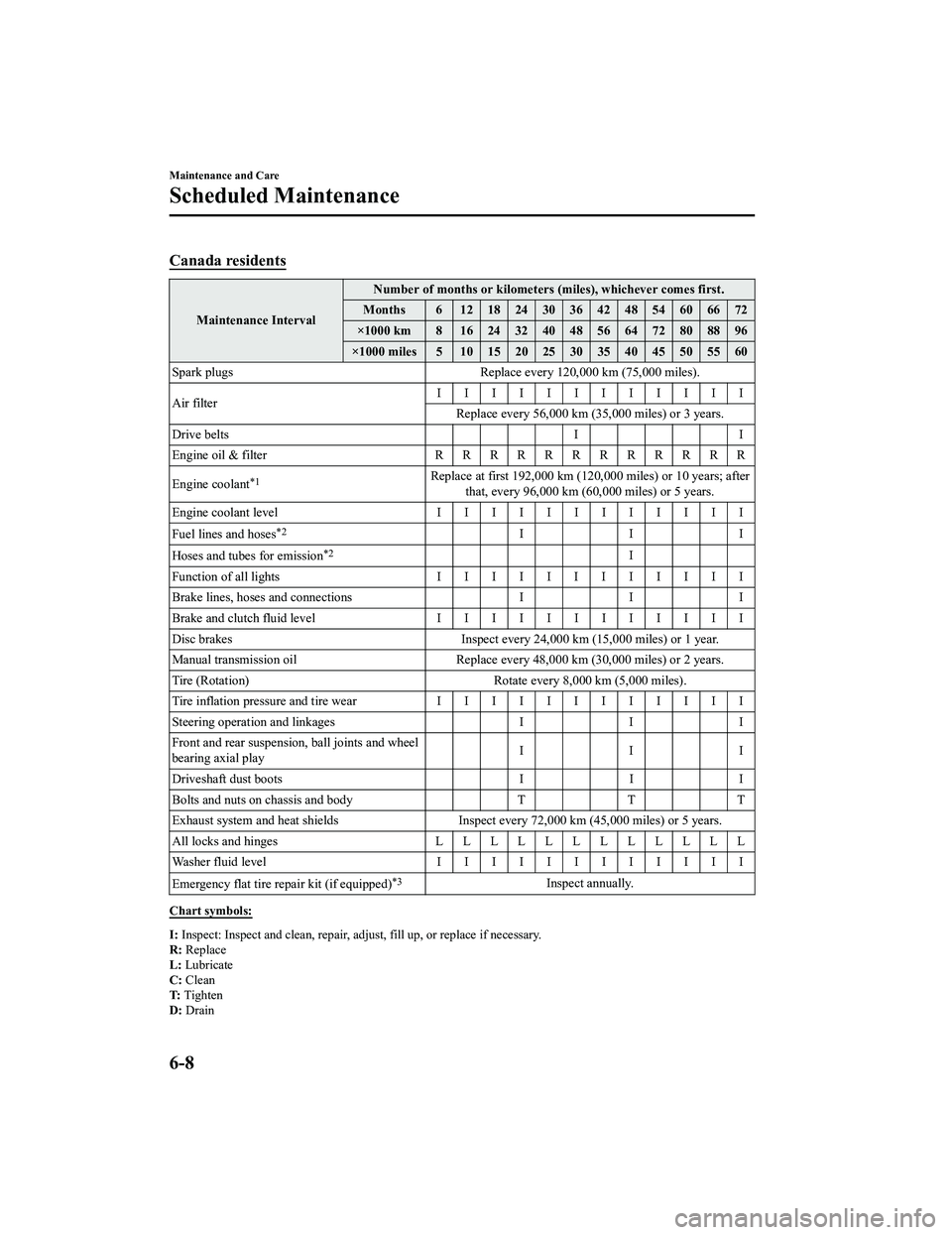
Canada residents
Maintenance IntervalNumber of months or kilometers (miles), whichever comes first.
Months 6 1218243036424854606672
×1000 km 8 1624324048566472808896
×1000 miles 5 10 15 20 25 30 35 40 45 50 55 60
Spark plugs Replace every 120,000 km (75,000 miles).
Air filter IIIIIIIIIIII
Replace every 56,000 km (35, 000 miles) or 3 years.
Drive belts II
Engine oil & filter RRRRRRRRRRRR
Engine coolant
*1Replace at first 192,000 km (120,000 miles) or 10 years; after
that, every 96,000 km (60,000 miles) or 5 years.
Engine coolant level IIIIIIIIIIII
Fuel lines and hoses
*2III
Hoses and tubes for emission
*2I
Function of all lights IIIIIIIIIIII
Brake lines, hoses and connections II I
Brake and clutch fluid level IIIIIIIIIIII
Disc brakes Inspect every 24,000 km (15,000 miles) or 1 year.
Manual transmission oil Replace every 48,000 km (30,000 mi les) or 2 years.
Tire (Rotation) Rotate every 8,000 km (5,000 miles).
Tire inflation pressure and tire wear IIIIIIIIIIII
Steering operation and linkages II I
Front and rear suspension, ball joints and wheel
bearing axial play III
Driveshaft dust boots II I
Bolts and nuts on chassis and body TTT
Exhaust system and heat shields Inspect every 72,000 km (45,000 miles) or 5 years.
All locks and hinges LLLLLLLLLLLL
Washer fluid level IIIIIIIIIIII
Emergency flat tire repair kit (if equipped)
*3Inspect annually.
Chart symbols:
I: Inspect: Inspect and clean, repair, ad just, fill up, or replace if necessary.
R: Replace
L: Lubricate
C: Clean
T: Tighten
D: Drain
Maintenance and Care
Scheduled Maintenance
6-8
MX-5_8KH8-EA-21K_Edition3_old 2021-11-10 13:10:56
Page 307 of 503
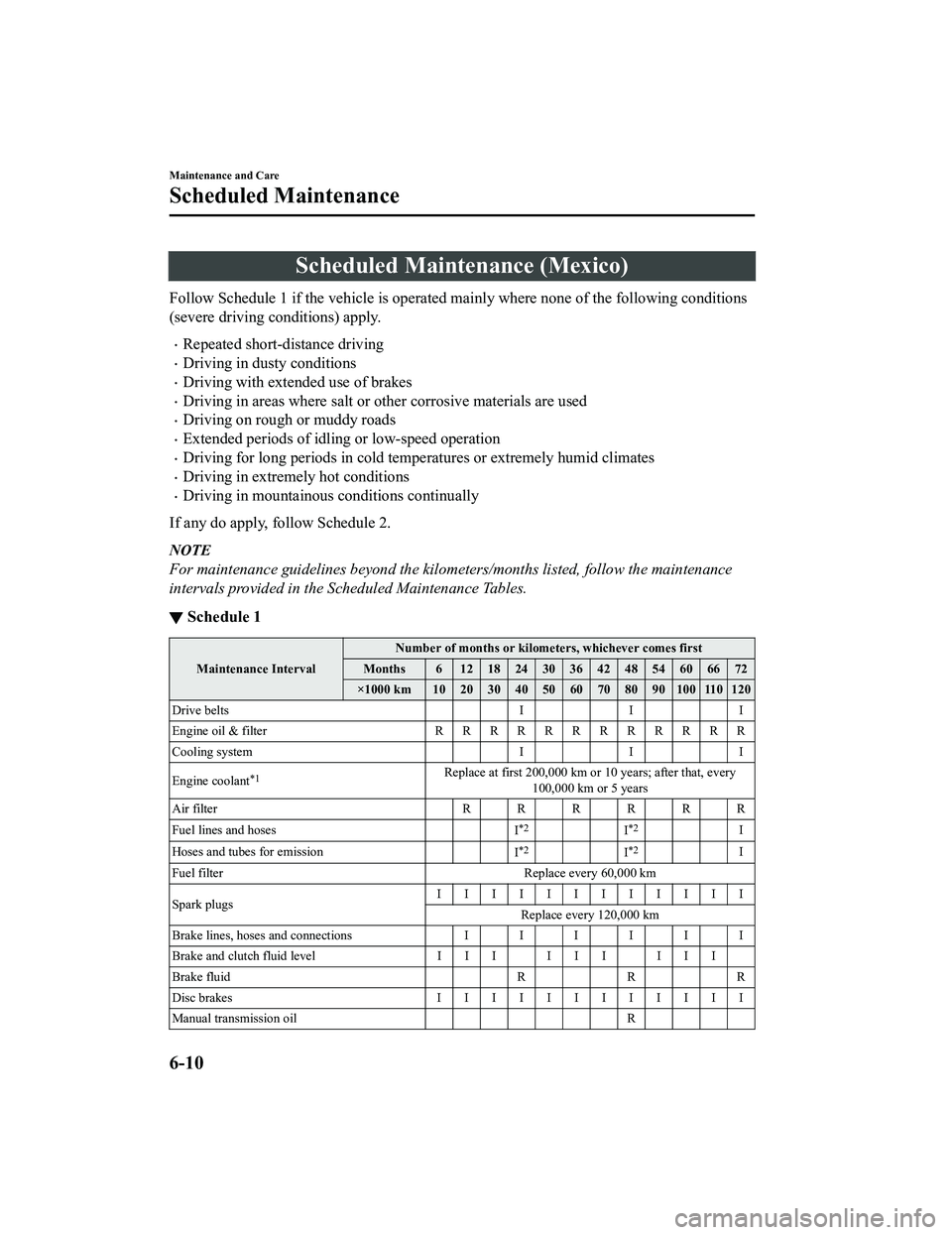
Scheduled Maintenance (Mexico)
Follow Schedule 1 if the vehicle is operated mainly where none of the following conditions
(severe driving conditions) apply.
Repeated short-distance driving
Driving in dusty conditions
Driving with extended use of brakes
Driving in areas where salt or other corrosive materials are used
Driving on rough or muddy roads
Extended periods of idling or low-speed operation
Driving for long periods in cold temperatures or extremely humid climates
Driving in extremely hot conditions
Driving in mountainous conditions continually
If any do apply, follow Schedule 2.
NOTE
For maintenance guidelines beyond the kilome ters/months listed, follow the maintenance
intervals provided in the Scheduled Maintenance Tables.
▼ Schedule 1
Maintenance Interval Number of months or kilometers, whichever comes first
Months 6 1218243036424854606672
×1000 km 10 20 30 40 50 60 70 80 90 100 110 120
Drive belts II I
Engine oil & filter RRRRRRRRRRRR
Cooling system II I
Engine coolant
*1Replace at first 200,000 km or 10 years; after that, every 100,000 km or 5 years
Air filter RRRRRR
Fuel lines and hoses I
*2I*2I
Hoses and tubes for emission I
*2I*2I
Fuel filter Replace every 60,000 km
Spark plugs IIIIIIIIIIII
Replace every 120,000 km
Brake lines, hoses and connections IIIIII
Brake and clutch fluid level I I I I I I I I I
Brake fluid RRR
Disc brakes IIIIIIIIIIII
Manual transmission oil R
Maintenance and Care
Scheduled Maintenance
6-10
MX-5_8KH8-EA-21K_Edition3_old 2021-11-10 13:10:56
Page 309 of 503
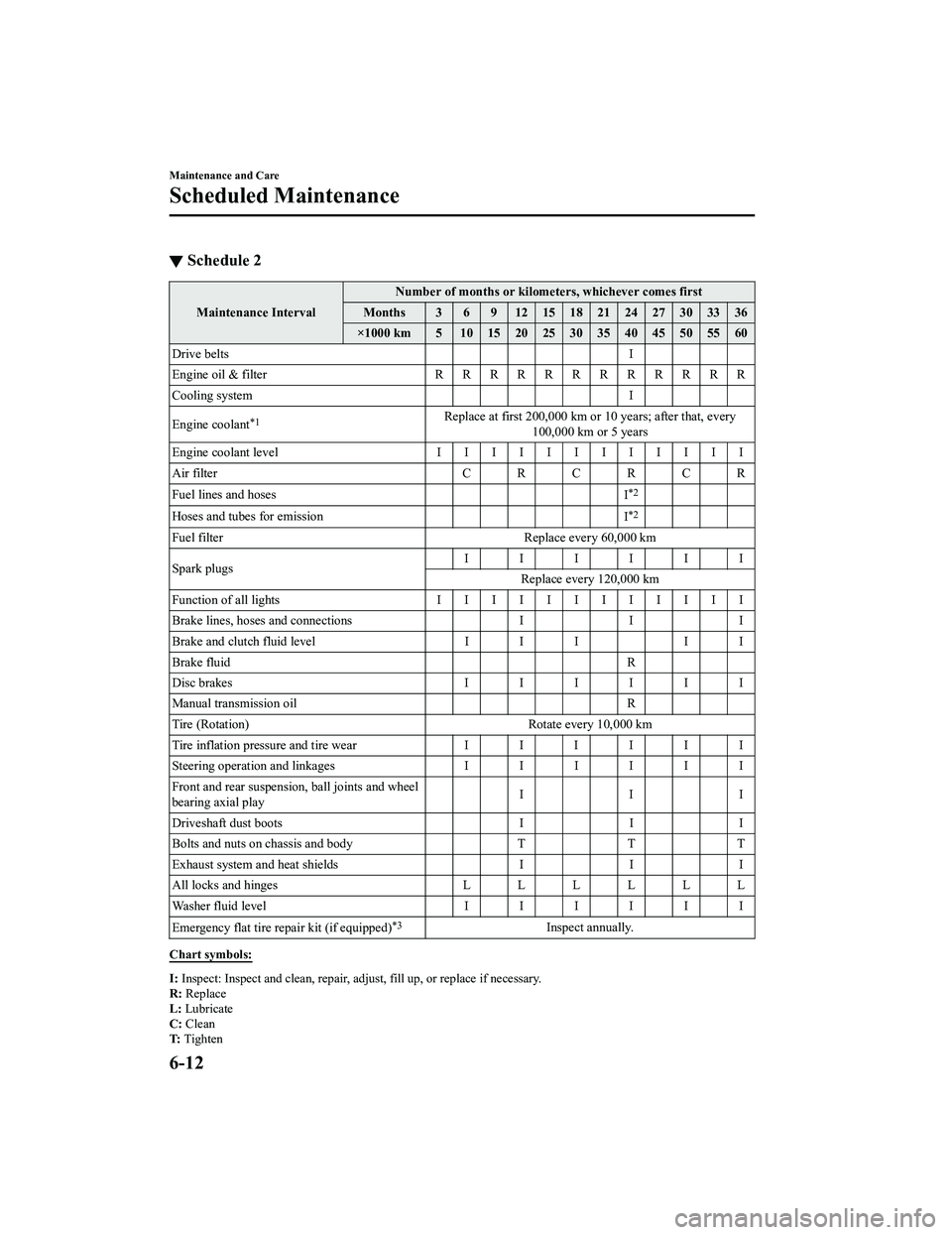
▼Schedule 2
Maintenance Interval Number of months or kilometers, whichever comes first
Months 3 6 9 121518212427303336
×1000 km 5 1015202530354045505560
Drive belts I
Engine oil & filter RRRRRRRRRRRR
Cooling system I
Engine coolant
*1Replace at first 200,000 km or 10 years; after that, every 100,000 km or 5 years
Engine coolant level IIIIIIIIIIII
Air filter CRCRCR
Fuel lines and hoses I
*2
Hoses and tubes for emissionI*2
Fuel filterReplace every 60,000 km
Spark plugs IIIIII
Replace every 120,000 km
Function of all lights IIIIIIIIIIII
Brake lines, hoses and connections II I
Brake and clutch fluid level I I II I
Brake fluid R
Disc brakes IIIIII
Manual transmission oil R
Tire (Rotation) Rotate every 10,000 km
Tire inflation pressure and tire wear IIIIII
Steering operation and linkages IIIIII
Front and rear suspension, ball joints and wheel
bearing axial play III
Driveshaft dust boots II I
Bolts and nuts on chassis and body TTT
Exhaust system and heat shields II I
All locks and hinges LLLLLL
Washer fluid level IIIIII
Emergency flat tire repair kit (if equipped)
*3Inspect annually.
Chart symbols:
I: Inspect: Inspect and clean, repair, ad just, fill up, or replace if necessary.
R: Replace
L: Lubricate
C: Clean
T: Tighten
Maintenance and Care
Scheduled Maintenance
6-12
MX-5_8KH8-EA-21K_Edition3_old 2021-11-10 13:10:56
Page 310 of 503
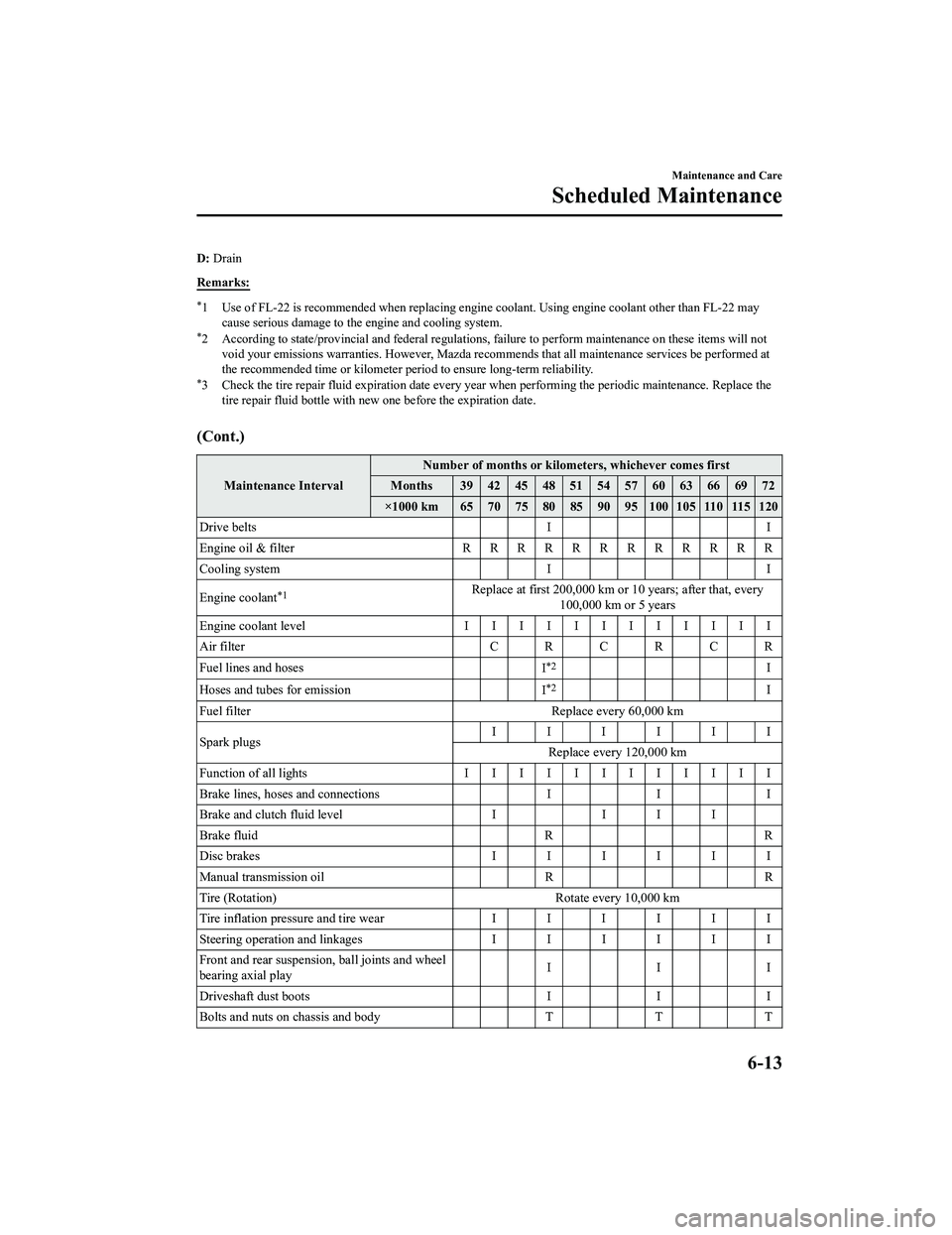
D: Drain
Remarks:
*1 Use of FL-22 is recommended when replacing engine coolant. Using engine coolant other than FL-22 may cause serious damage to the engine and cooling system.
*2 According to state/provincial and federal regulations , failure to perform maintenance on these items will not
void your emissions warranties. However, Mazda recomme nds that all maintenance services be performed at
the recommended time or kilometer period to ensure long-term reliability.
*3 Check the tire repair fluid expiration date every year when performing the periodic maintenance. Replace the tire repair fluid bottle with new one before the expiration date.
(Cont.)
Maintenance Interval Number of months or kilometers, whichever comes first
Months 39 42 45 48 51 54 57 60 63 66 69 72
×1000 km 65 70 75 80 85 90 95 100 105 110 115 120
Drive belts II
Engine oil & filter R R R R R R R R R R R R
Cooling system II
Engine coolant
*1Replace at first 200,000 km or 10 years; after that, every 100,000 km or 5 years
Engine coolant level IIIIIIIIIIII
Air filter CRCRCR
Fuel lines and hoses I
*2I
Hoses and tubes for emission I
*2I
Fuel filter Replace every 60,000 km
Spark plugs IIIIII
Replace every 120,000 km
Function of all lights I I I I I I I I I I I I
Brake lines, hoses and connections III
Brake and clutch fluid level II I I
Brake fluid RR
Disc brakes IIIIII
Manual transmission oil RR
Tire (Rotation) Rotate every 10,000 km
Tire inflation pressure and tire wear IIIIII
Steering operation and linkages IIIIII
Front and rear suspensi on, ball joints and wheel
bearing axial play III
Driveshaft dust boots III
Bolts and nuts on chassis and body TT T
Maintenance and Care
Scheduled Maintenance
6-13
MX-5_8KH8-EA-21K_Edition3_old 2021-11-10 13:10:56
Page 363 of 503

▼Cleaning the Window Interiors
If the windows become covered with an
oily, greasy, or waxy film, clean them with
glass cleaner. Follow the directions on the
container.
CAUTION
Do not scrape or scratch the inside of the
window glass. It could damage the
thermal filaments.
When washing the inside of the window
glass, use a soft cloth dampened in
lukewarm water, gently wiping the
thermal filaments.
Use of glass cleaning products could
damage the thermal
filaments.
▼Cleaning the Floor Mats
Rubber floor mats should be cleaned with
mild soap and water only.
WA R N I N G
Do not use rubber cleaners, such as tire
cleaner or tire shine, when cleaning rubber
floor mats:
Cleaning the rubber
floor mats with rubber
cleaning products makes the floor mats
slippery.
This may cause an accident when
depressing the accelerator, brake, or clutch
(Manual transmission) pedal or when
getting in or out of the vehicle.
After removing the floor mats for
cleaning, always reinstall them securely
(page 3-49).
Maintenance and Care
Appearance Care
6-66
MX-5_8KH8-EA-21K_Edition3_old 2021-11-10 13:10:56
Page 369 of 503

WA R N I N G
Do not allow children to touch the tire
sealant:
Ingestion of tire sealant is dangerous. In
the event tire sealant is accidentally
swallowed, drink large amounts of water
immediately and seek medical
assistance.
Tire sealant that comes into contact with
the eyes and skin is dangerous. If tire
sealant enters the eyes or contacts the
skin, flush immediately with large
amounts of water and seek medical
assistance.
NOTE
The tire sealant cannot be reused.
Purchase new tire sealant at an
Authorized Mazda Dealer.
The emergency flat tire repair kit cannot
be used in the following cases.
Consult an Authorized Mazda Dealer.
The period of effective use for the tire
sealant has expired. (The period of
effectiveness is indicated on the bottle
label.)
The tear or puncture exceeds about 4
mm (0.16 in).
The damage has occurred to an area
of the tire other than the tread.
The vehicle has been driven with
nearly no air remaining in the tire.
The tire has come off the wheel rim.
Damage to the wheel rim has
occurred.
The tire has two or more punctures.
▼ Using the Emergency Flat Tire
Repair Kit
U.S.A. and Canada
1. Move the vehicle off the right-of-way
to a safe place on a level and hard
surface where the vehicle does not
obstruct traffic.
2. Shift the shift lever to the 1 or Reverse (R) position for a manual transmission,
and shift the selector lever to the P
position for an automatic transmission.
3. Apply the parking brake with the brake pedal depressed and turn off the
engine.
4. If necessary, flash the hazard warning
lights and set up the roadside
emergency triangle.
5. Unload passengers and cargo and
remove the emergency flat tire repair
kit.
Hardtop modelSoft top model
If Trouble Arises
Flat Tire
7-6
MX-5_8KH8-EA-21K_Edition3_old
2021-11-10 13:10:56
Page 380 of 503
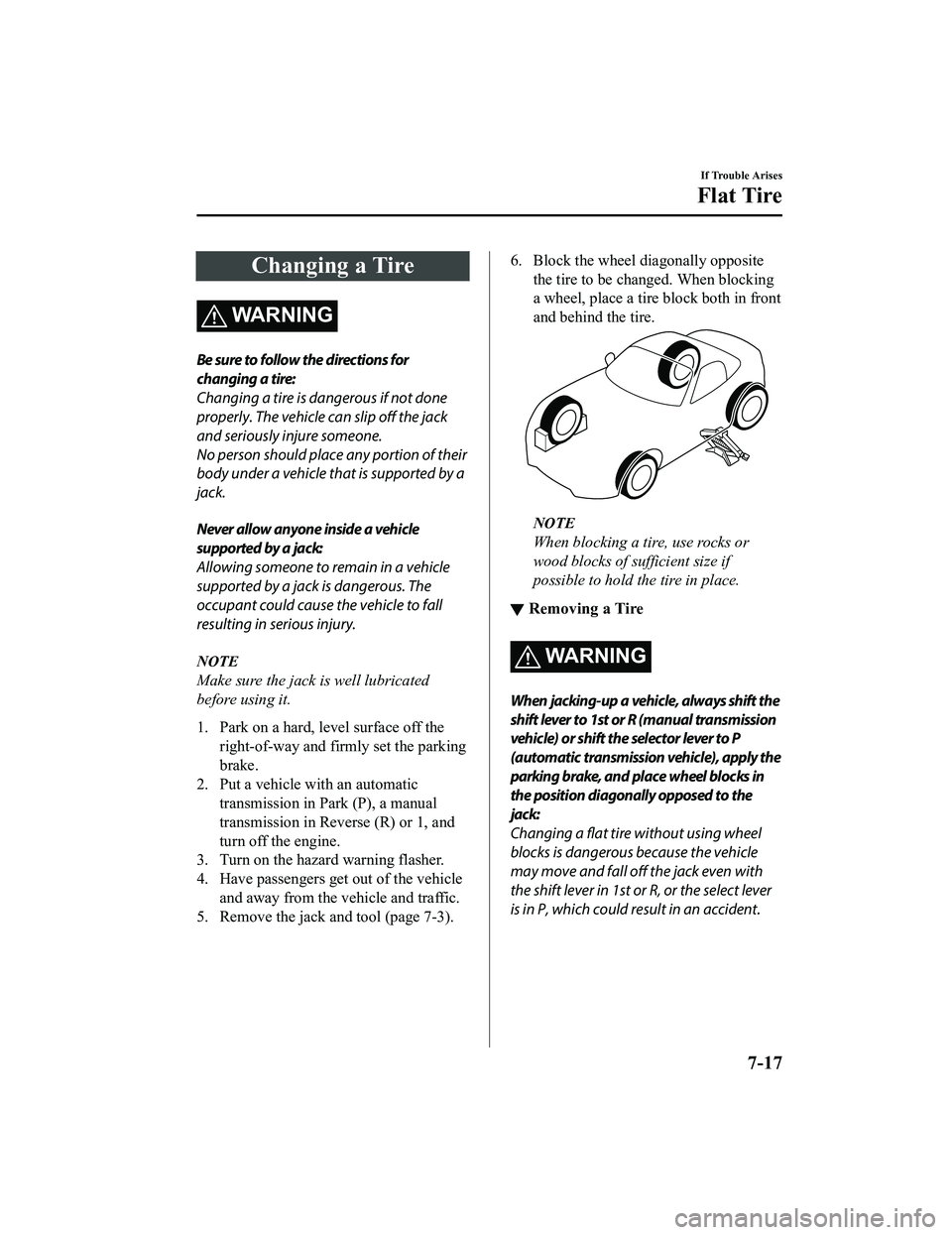
Changing a Tire
WARNING
Be sure to follow the directions for
changing a tire:
Changing a tire is dangerous if not done
properly. The vehicle can slip off the jack
and seriously injure someone.
No person should place any portion of their
body under a vehicle that is supported by a
jack.
Never allow anyone inside a vehicle
supported by a jack:
Allowing someone to remain in a vehicle
supported by a jack is dangerous. The
occupant could cause the vehicle to fall
resulting in serious injury.
NOTE
Make sure the jack is well lubricated
before using it.
1. Park on a hard, level surface off the right-of-way and firmly set the parking
brake.
2. Put a vehicle with an automatic
transmission in Park (P), a manual
transmission in Reverse (R) or 1, and
turn off the engine.
3. Turn on the hazard warning flasher.
4. Have passengers get out of the vehicle and away from the vehicle and traffic.
5. Remove the jack and tool (page 7-3).
6. Block the wheel diagonally opposite the tire to be changed. When blocking
a wheel, place a tire block both in front
and behind the tire.
NOTE
When blocking a tire, use rocks or
wood blocks of sufficient size if
possible to hold the tire in place.
▼Removing a Tire
WA R N I N G
When jacking-up a vehicle, always shift the
shift lever to 1st or R (manual transmission
vehicle) or shift the selector lever to P
(automatic transmission vehicle), apply the
parking brake, and place wheel blocks in
the position diagonally opposed to the
jack:
Changing a
flat tire without using wheel
blocks is dangerous because the vehicle
may move and fall off the jack even with
the shift lever in 1st or R, or the select lever
is in P, which could result in an accident.
If Trouble Arises
Flat Tire
7-17
MX-5_8KH8-EA-21K_Edition3_old 2021-11-10 13:10:56
Page 389 of 503

Starting a Flooded Engine
If the engine fails to start, it may be
flooded (excessive fuel in the engine).
Follow this procedure:
1. If the engine does not start within 5seconds on the first try, wait 10
seconds and try again.
2. Make sure the parking brake is on.
3. Depress the accelerator all the way and hold it there.
4. Depress the clutch pedal (Manual transmission) or the brake pedal
(Automatic transmission), then press
the push button start. If the engine
starts, release the accelerator
immediately because the engine will
suddenly rev up.
5. If the engine fails to start, crank it
without depressing the accelerator.
If the engine still does not start using the
previous procedure, have your vehicle
inspected by an Authorized Mazda Dealer.
Push-Starting
Do not push-start your Mazda.
WA R N I N G
Never tow a vehicle to start it:
Towing a vehicle to start it is dangerous.
The vehicle being towed could surge
forward when its engine starts, causing the
2 vehicles to collide. The occupants could
be injured.
CAUTION
Do not push-start a vehicle that has a
manual transmission. It can damage the
emission control system.
NOTE
You cannot start a vehicle with an
automatic transmission by pushing it.
If Trouble Arises
Emergency Starting
7-26
MX-5_8KH8-EA-21K_Edition3_old 2021-11-10 13:10:56
Page 390 of 503
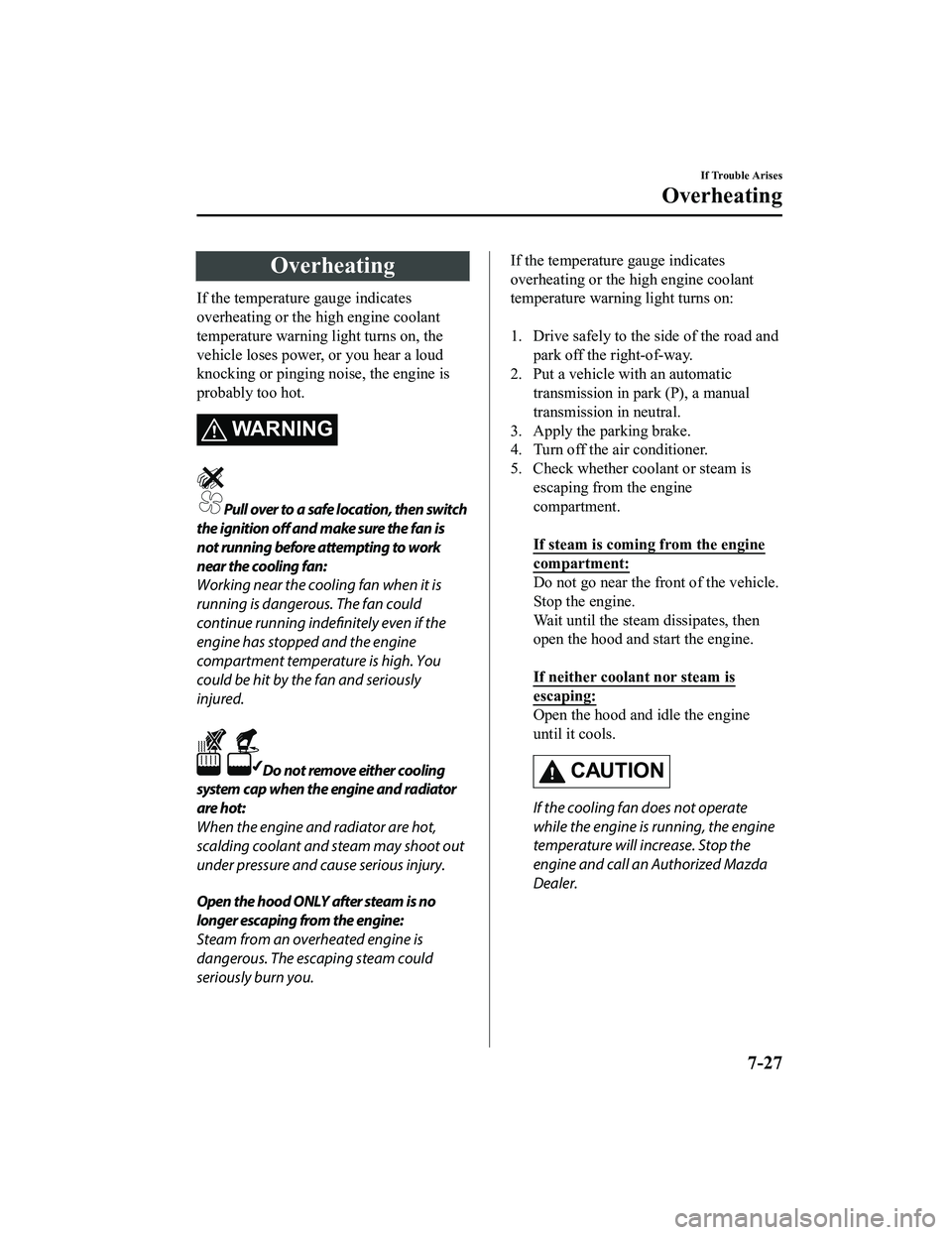
Overheating
If the temperature gauge indicates
overheating or the high engine coolant
temperature warning light turns on, the
vehicle loses power, or you hear a loud
knocking or pinging noise, the engine is
probably too hot.
WARNING
Pull over to a safe location, then switch
the ignition off and make sure the fan is
not running before attempting to work
near the cooling fan:
Working near the cooling fan when it is
running is dangerous. The fan could
continue running indefinitely even if the
engine has stopped and the engine
compartment temperature is high. You
could be hit by the fan and seriously
injured.
Do not remove either cooling
system cap when the engine and radiator
are hot:
When the engine and radiator are hot,
scalding coolant and steam may shoot out
under pressure and cause serious injury.
Open the hood ONLY after steam is no
longer escaping from the engine:
Steam from an overheated engine is
dangerous. The escaping steam could
seriously burn you.
If the temperature gauge indicates
overheating or the high engine coolant
temperature warning light turns on:
1. Drive safely to the side of the road and
park off the right-of-way.
2. Put a vehicle with an automatic transmission in park (P), a manual
transmission in neutral.
3. Apply the parking brake.
4. Turn off the air conditioner.
5. Check whether coolant or steam is escaping from the engine
compartment.
If steam is coming from the engine
compartment:
Do not go near the front of the vehicle.
Stop the engine.
Wait until the steam dissipates, then
open the hood and start the engine.
If neither coolant nor steam is
escaping:
Open the hood and idle the engine
until it cools.
CAUTION
If the cooling fan does not operate
while the engine is running, the engine
temperature will increase. Stop the
engine and call an Authorized Mazda
Dealer.
If Trouble Arises
Overheating
7-27
MX-5_8KH8-EA-21K_Edition3_old 2021-11-10 13:10:56
Page 422 of 503

▼Manual closing
Before closing manually
WARNING
Verify that the ignition is switched off
before manually operating the roof:
Manually closing the roof with the ignition
not switched
off is dangerous as the
motors could turn on suddenly and cause
injury resulting from hands or fingers being
pinched in the mechanism.
1. Park on a hard, level surface off the right-of-way and firmly set the parking
brake.
2. Put a vehicle with an automatic transmission in Park (P), a manual
transmission in Neutral.
3. Switch the ignition off while
depressing the brake pedal.
4. Turn on the hazard warning flasher if it is needed.
Tool preparation
Take out the five tool s stored in the seat
side box.
Refer to Seat Side Box on page 5-42.
Wire Gear
(tool kit) Rope
L-shaped
hexagonal wrench
(Small) L-shaped
hexagonal wrench
(Lar
ge)
Opening the rear roof
CAUTION
When turning the bolt, cover the front
roof using a cloth. The front roof may be
damaged if the L-shaped hexagonal
wrench contacts it.
Because the clearance with the stored
front roof is narrow, be careful not to let
the L-shape hexagonal wrench contact
the roof when turning the bolt.
NOTE
Moving the seats as far forward as
possible and folding the seatbacks forward
will facilitate the procedure.
Refer to Adjusting the Driver's Seat on
page 2-5.
Refer to Adjusting the Passenger's Seat on
page 2-10.
1. Remove the antenna if it is installed.
2. Insert the short end of the L-shaped
hexagonal wrench (Large) into the
motor bracket bolt.
Bolt
If Trouble Arises
When the Roof Cannot be Closed
7-59
MX-5_8KH8-EA-21K_Edition3_old 2021-11-10 13:10:56